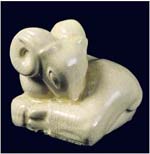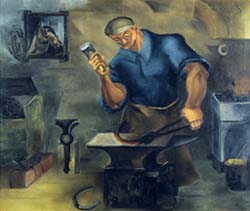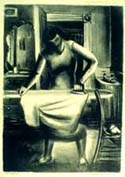WPA Art and Visual Elements
of Art
Objectives:
1) Students will recognize in works of art the following formal elements:
visual and tactile texture; shape or contour; value. They will choose
a group of WPA artworks for each category of element from the images
in the ISM's WPA Collection Online Photo Gallery (https://webdev.museum.state.il.us/ismdepts/art/collections/wpa/
, and write a paragraph about how each artist addressed the element
in his or her piece.
2)
Each student will choose one element they worked with above and create
a 2-D or 3-D work of art that embodies this element strongly.
 Emmanuel
Viviano's Ram has a smooth, shiny texture
Emmanuel
Viviano's Ram has a smooth, shiny texture
Motivation:
Artists usually have a favorite medium in which they work. Each medium
has its own characteristics. For example, artists who like to work with
values, that is, tints and shades of black-to-white, can choose print
media or pen and ink or pencil. Artists who like to express themselves
with shape and contour may create sculptures (or paint strong positive
and negative shapes in two-dimension). Textures can be created in sculpture
and in drawing techniques. The ultimate example of visual textures is
trompe l'oeuil painting. Define in class discussion the meaning and
application of the three elements of art.
Materials:
computer with Internet access pencil and paper art materials of the
students' or teachers' choice.
 Leon
Garland's Blacksmith has lots of rectangular shapes
Leon
Garland's Blacksmith has lots of rectangular shapes
Procedure:
Have the class discussion outlined in the Motivation section.
Students
will view the WPA Collection Photo Gallery.
They will choose one or more works of art for each of the three elements
of art: texture, shape, and value.
Each student will write a paragraph about how each chosen artwork addresses
an element (how the artist used the medium to enhance the effect of
the element in their work). (Be sure they list the Title and Artist's
name and the medium used.)
Before
they create their own artwork, students should discuss their findings
of art elements, comparing and critiquing one another's observations.
One work of art could be chosen to represent more than one element.
Several artworks, seemingly very different, could have the same elementemphasized
in common.
Students will choose one element with which to create a work of art
themselves with the medium of their choice.
Students will create the artwork, present it for display, and participate
in a class discussion of artworks. Suggestion: Sort the artworks into
groups by element, discussing any disagreements (there may be more than
one opinion for each work).
Assessment:
Student paragraphs should reflect the definitions they learned of the
chosen elements.
Class discussion is part of the assessment: viewers should somewhat
agree as to what element the student was addressing and why a medium
is especially appropriate for addressing an element.
The teacher and the artist will evaluate how well the student incorporated
the element into the work. (Clearly, moderately, poorly) (if the last
two, discuss how it could be enhanced to improve the assignment - without
ruining the integrity of the work).
Max
Kahn's Ironing has values of black and white
 Illinois
State Board of Education Goals and Standards Addressed:
Illinois
State Board of Education Goals and Standards Addressed:
Visual Arts: Language of Arts
Early
Elementary: 25.A.1d Identify the elements
of line, shape, space, color and texture; the principles of repetition
and pattern; and the expressive qualities of mood, emotion and pictorial
representation.
Late Elementary: 25.A.2d Identify and describe the elements of
2- and 3-dimensional space, figure ground, value and form; the principles
of rhythm, size, proportion and composition; and the expressive qualities
of symbol and story.
Middle School: 25.A.3d Identify and describe the elements of
value, perspective and color schemes; the principles of contrast, emphasis
and unity; and the expressive qualities of thematic development and
sequence.
Early High School: 25.B.4 Analyze and evaluate similar and distinctive
characteristics of works in two or more of the arts that share the same
historical period or societal context.

